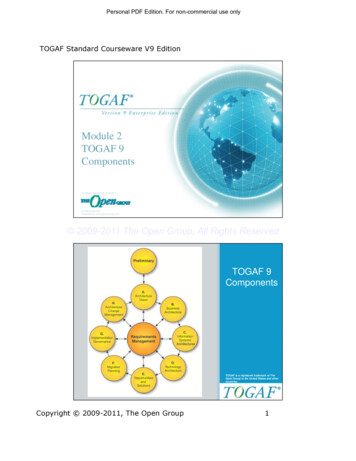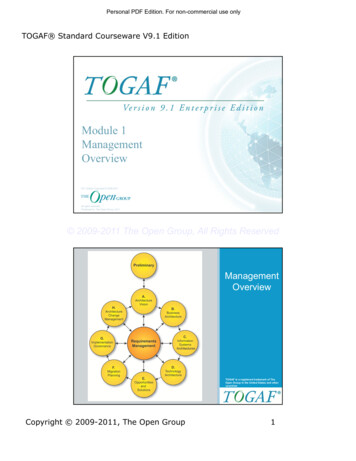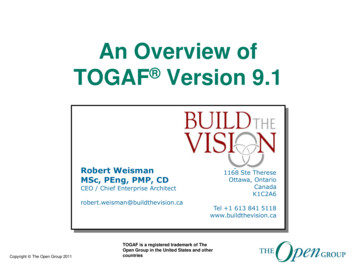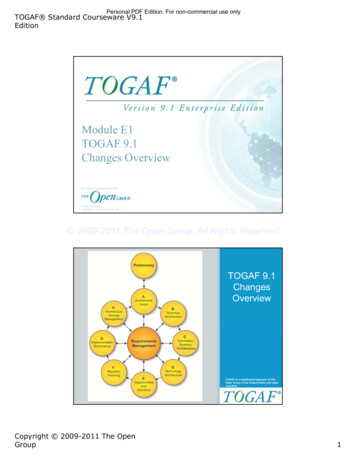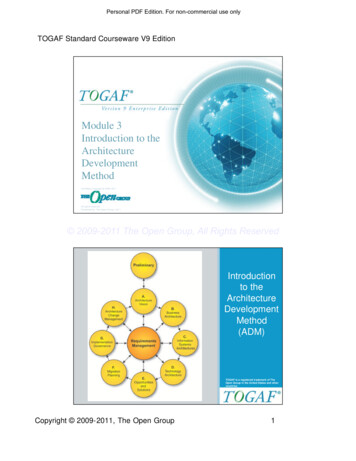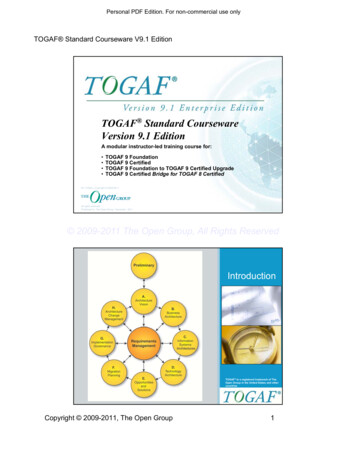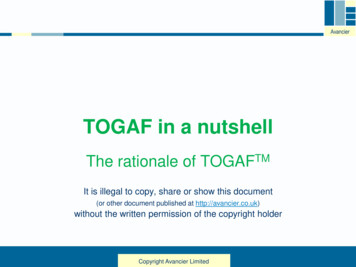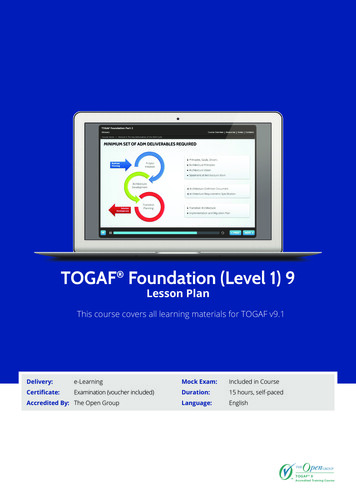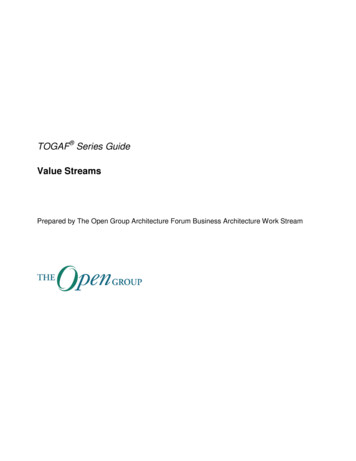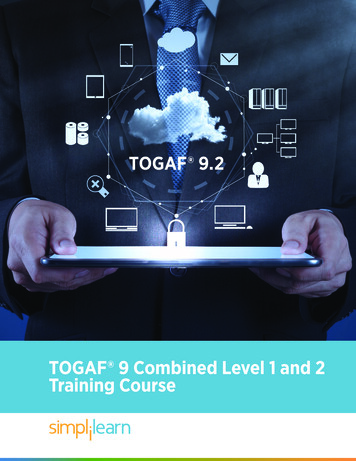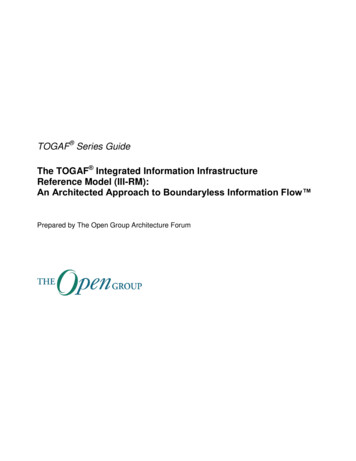
Transcription
TOGAF Series GuideThe TOGAF Integrated Information InfrastructureReference Model (III-RM):An Architected Approach to Boundaryless Information Flow Prepared by The Open Group Architecture Forum
Copyright 2017, The Open Group. All rights reserved.No part of this publication may be reproduced, stored in a retrieval system, or transmitted, in any form or by any means,electronic, mechanical, photocopying, recording, or otherwise, without the prior permission of the copyright owner.This Guide has not been verified for avoidance of possible third-party proprietary rights. In implementing this Guide,usual procedures to ensure the respect of possible third-party intellectual property rights should be followed.TOGAF Series GuideThe TOGAF Integrated Information Infrastructure Reference Model (III-RM)ISBN:1-947754-03-4Document Number:G179Published by The Open Group, November 2017.Updated in May 2018 to reference the TOGAF Standard, Version 9.2.Comments relating to the material contained in this document may be submitted to:The Open Group, Apex Plaza, Forbury Road, Reading, Berkshire, RG1 1AX, United Kingdomor by electronic mail to:ogspecs@opengroup.orgiiTOGAF Series Guide (2017)
Contents 1Overview . 11.1 Background . 11.2 Components of the Model. 11.3 Relationship to Other Parts of the TOGAF Framework . 21.4 Key Business and Technical Drivers . 21.4.1Problem Space: The Need for BoundarylessInformation Flow. 21.4.2Solution Space: The Need for Integrated InformationInfrastructure . 31.5 Status of the III-RM . 42High-Level View. 62.1 Derivation of the III-RM from the TRM . 62.2 High-Level III-RM Graphic. 72.3 Components of the High-Level III-RM . 83Detailed Taxonomy . 103.1 Detailed III-RM Graphic . 103.2 Business Applications . 103.2.1Brokering Applications . 113.2.2Information Provider Applications . 123.2.3Information Consumer Applications . 133.3 Infrastructure Applications . 143.3.1Development Tools . 143.3.2Management Utilities . 153.4 Application Platform. 163.4.1Software Engineering Services. 163.4.2Security Services . 173.4.3Location and Directory Services . 173.4.4Human Interaction Services . 183.4.5Data Interchange Services . 193.4.6Data Management Services . 193.4.7Additional Operating System Services . 193.5 Qualities . 20The TOGAF Integrated Information Infrastructure Reference Model (III-RM)iii
PrefaceThe Open GroupThe Open Group is a global consortium that enables the achievement of business objectivesthrough technology standards. Our diverse membership of more than 600 organizations includescustomers, systems and solutions suppliers, tools vendors, integrators, academics, andconsultants across multiple industries.The Open Group aims to: Capture, understand, and address current and emerging requirements, and establishpolicies and share best practices Facilitate interoperability, develop consensus, and evolve and integrate specifications andopen source technologies Operate the industry’s premier certification serviceFurther information on The Open Group is available at www.opengroup.org.The Open Group publishes a wide range of technical documentation, most of which is focusedon development of Open Group Standards and Guides, but which also includes white papers,technical studies, certification and testing documentation, and business titles. Full details and acatalog are available at www.opengroup.org/library. The TOGAF Standard, a Standard of The Open GroupThe TOGAF standard is a proven enterprise methodology and framework used by the world’sleading organizations to improve business efficiency.This DocumentThis document is a TOGAF Series Guide to the TOGAF Integrated Information InfrastructureReference Model (III-RM). It has been developed and approved by The Open Group.For more than 15 years, The Open Group has been acting on a vision of BoundarylessInformation Flow , achieved through global interoperability in a secure, reliable, and timelyfashion.For too long, IT customers have had to pay for the failure of IT suppliers to get their products towork together effectively. To avoid negatively impacting business, IT customers have often hadno choice but to pay for “integration services” that simply consume development budget todayand increase maintenance costs down the road.ivTOGAF Series Guide (2017)
To further this aim, in 2001-2, The Open Group developed a business scenario1 that describedthe problem caused by the lack of interoperability.The Integrated Information Infrastructure Reference Model (III-RM) demonstrates anarchitected approach to enable Boundaryless Information Flow.This document describes the III-RM in terms of its concepts, an overview, and its detailedtaxonomy.This Guide is structured as follows: Chapter 1 (Overview) examines the concept of Boundaryless Information Flow; why anintegrated information infrastructure is necessary to enable it; and how the III-RM canhelp the architect in designing an integrated information infrastructure for their enterprise Chapter 2 (High-Level View) provides a high-level view of the III-RM, includingderivation of the model, high-level graphic, and components Chapter 3 (Detailed Taxonomy) provides a detailed taxonomy of the III-RM, includingdetailed graphic, platform service categories, and external environment sub-entitiesStatus of This DocumentThis Guide is a historical record of the model developed in 2002. The underlying principles ofBoundaryless Information Flow and the III-RM remain sound, but the detailed taxonomydescribed in Chapter 3 is no longer complete or representative of the IT landscape in 2017. About the TOGAF Series GuidesThe TOGAF Series Guides contain guidance on how to use the TOGAF framework. They formpart of the TOGAF Body of Knowledge.The TOGAF Series Guides are expected to be the most rapidly developing part of the TOGAFdocument set. While the TOGAF framework is expected to be long-lived and stable, guidance onthe use of the TOGAF framework can be industry, architectural style, purpose, and problemspecific. For example, the stakeholders, concerns, views, and supporting models required tosupport the transformation of an extended enterprise may be significantly different than thoseused to support the transition of an in-house IT environment to the cloud; both will use theArchitecture Development Method (ADM), start with an Architecture Vision, and develop aTarget Architecture on the way to an Implementation and Migration Plan. The TOGAFframework remains the essential scaffolding across industry, domain, and style.1Interoperable Enterprise, Business Scenario (K022), October 2002, published by The Open Group (see Referenced Documents). The TOGAF Integrated Information Infrastructure Reference Model (III-RM)v
TrademarksArchiMate , DirecNet , Making Standards Work , OpenPegasus , Platform 3.0 , The OpenGroup , TOGAF , UNIX , UNIXWARE , and the Open Brand X logo are registeredtrademarks and Boundaryless Information Flow , Build with Integrity Buy with Confidence ,Dependability Through Assuredness , Digital Practitioner Body of Knowledge , DPBoK ,EMMM , FACE , the FACE logo, IT4IT , the IT4IT logo, O-DEF , O-PAS , OpenFAIR , Open O logo, Open Platform 3.0 , Open Process Automation , Open TrustedTechnology Provider , SOSA , and The Open Group Certification logo (Open O andcheck ) are trademarks of The Open Group.All other brands, company, and product names are used for identification purposes only and maybe trademarks that are the sole property of their respective owners.viTOGAF Series Guide (2017)
AcknowledgementsThe Open Group gratefully acknowledges past and present members of The Open GroupArchitecture Forum for their contribution in the development of this Guide. The TOGAF Integrated Information Infrastructure Reference Model (III-RM)vii
Referenced DocumentsThe following documents are referenced in this Guide.viii Interoperable Enterprise, Business Scenario (K022), October 2002, published by TheOpen Group; refer to: www.opengroup.org/library/k022 The TOGAF Technical Reference Model, TOGAF Series Guide (G175), September2017, published by The Open Group; refer to: www.opengroup.org/library/g175 The TOGAF Standard, Version 9.2, a standard of The Open Group (C182), published byThe Open Group, April 2018; refer to: www.opengroup.org/library/c182TOGAF Series Guide (2017)
1Overview1.1BackgroundWith the emergence of Internet-based technologies and cloud computing, the main focus ofattention for many organizations, and the main return on investment in architecture effort, hasshifted from only being Application Platform space to include Application Software. TheTOGAF Technical Reference Model, described in the TOGAF Technical Reference Model(TRM) Guide,2 focuses on the Application Platform space.This Guide describes a reference model that focuses on the Application Software space, and“Common Systems Architecture” in Enterprise Continuum terms. This is the IntegratedInformation Infrastructure Reference Model (III-RM).The III-RM is a subset of the TOGAF TRM in terms of its overall scope, but it also expandscertain parts of the TRM – in particular, the Business Applications and InfrastructureApplications parts – in order to provide help in addressing one of the key challenges facing theEnterprise Architect today: the need to design an integrated information infrastructure to enableBoundaryless Information Flow . These concepts are explained in detail below.This introductory section examines the concept of Boundaryless Information Flow; why anintegrated information infrastructure is necessary to enable it; and how the III-RM can help thearchitect in designing an integrated information infrastructure for their enterprise.1.2Components of the ModelLike the TOGAF TRM, the III-RM has two main components: A taxonomy, which defines terminology, and provides a coherent description of thecomponents and conceptual structure of an integrated information infrastructure An associated III-RM graphic, which provides a visual representation of the taxonomy,and the inter-relationship of the components, as an aid to understandingThe III-RM model assumes the underlying existence of a computing and network platform, asdescribed in the TRM; these are not depicted in the III-RM model.2The TOGAF Technical Reference Model (TRM), TOGAF Series Guide (G175), September 2017, published by The Open Group(see Referenced Documents). The TOGAF Integrated Information Infrastructure Reference Model (III-RM)1
1.3Relationship to Other Parts of the TOGAF FrameworkThe relationship of the III-RM to the TRM is explained in Section 2.1.Although the III-RM is intended as a useful tool in the execution of the TOGAF ArchitectureDevelopment Method (ADM), it is important to emphasize that the ADM is in no way dependenton the use of the III-RM (any more than it is dependent on use of the TRM). Other taxonomiesand reference models exist in this space that can be used in conjunction with the ADM, andindeed may be preferable for some organizations.1.4Key Business and Technical Drivers1.4.1Problem Space: The Need for Boundaryless Information FlowThe Boundaryless Information Flow problem space is one that is shared by many customermembers of The Open Group, and by many similar organizations worldwide. It is essentially theproblem of getting information to the right people at the right time in a secure, reliable manner,in order to support the operations that are core to the extended enterprise.In General Electric, Jack Welch invented the term "the Boundaryless Organization", not to implythat there are no boundaries, but that they should be made permeable.Creating organizational structures that enabled each individual department to operate atmaximum efficiency was for a long time accepted as the best approach to managing a largeenterprise. Among other benefits, this approach fostered the development of specialist skills instaff, who could apply those skills to specific aspects of an overall activity (such as amanufacturing process), in order to accomplish the tasks involved better, faster, and cheaper.As each overall activity progressed through the organization, passing from department todepartment (for example, from Design to Production to Sales), each department would takeinputs from the previous department in the process, apply its own business processes to theactivity, and send its output to the next department in line.In today's world where speed, flexibility, and responsiveness to changing markets make all thedifference between success and failure, this method of working is no longer appropriate.Organizations have been trying for some time to overcome the limitations imposed by traditionalorganization structures. Many business process re-engineering efforts have been undertaken andabandoned because they were too ambitious, while others cost far more in both time and moneythan originally intended.However, organizations today recognize that they need not abandon functional or departmentalorganization altogether. They can enable the right people to come together in cross-functionalteams so that all the skills, knowledge, and expertise can be brought to bear on any specificproblem or business opportunity.But this in turn poses its own challenges. CIOs are under enormous pressure to provide access toinformation to each cross-functional team on an as-required basis, and yet the sources of thisdata can be numerous and the volumes huge.2TOGAF Series Guide (2017)
Even worse, the IT systems, which have been built over a period of 20 or 30 years at a cost ofmany billions of dollars, and are not about to be thrown out or replaced wholesale, were built foreach functional department. So although it may be possible to get people to work togethereffectively (no minor achievement in itself), the IT systems they use are designed to support theold-style thinking. The IT systems in place today do not allow for information to flow in supportof the boundaryless organization. When they do, then we will have Boundaryless InformationFlow.1.4.2Solution Space: The Need for Integrated Information InfrastructureThe Open Group Interoperable Enterprise Business Scenario, originally published in 2002,crystallized this need for Boundaryless Information Flow and described the way in which thisneed drives IT customers’ deployment of their information infrastructure.In this scenario, the customer’s problem statement says that I (as the customer enterprise) couldgain significant operational efficiencies and improve the many different business processes ofthe enterprise – both internal processes, and those spanning the key interactions with suppliers,customers, and partners – if only I could provide my staff with: Integrated information so that different and potentially conflicting pieces of informationare not distributed throughout different systems Integrated access to that information so that staff can access all the information they needand have a right to, through one convenient interfaceThe infrastructure that enables this vision is termed the “integrated information infrastructure”.As an example, one current approach to integrated information infrastructure is to provide“enterprise portals” that allow integrated access to information from different applicationssystems enterprise-wide, via a convenient, web-enabled interface (one of the colored segments inthe ends of the cylinder in Figure 1). The TOGAF Integrated Information Infrastructure Reference Model (III-RM)3
Figure 1: An Approach to Boundaryless Information Flow (Enterprise Portals)One of the key challenges for the architect in today’s enterprise is to work out, and thencommunicate to senior management, how far disruptive technologies and new trends might havean impact on business and on the way the different elements of the organization’s ecosystemcould be connected and interchange information (Boundaryless Information Flow).The Open Group follow-up analysis of the Interoperable Enterprise Business Scenario hasresulted in the development of an integrated information infrastructure model (the III-RM),which depicts the major components required to address the Boundaryless Information Flowproblem space, and can help the architect in this task.The III-RM thus provides insights related to customer needs for Boundaryless Information Flowin enterprise environments. The model also points to rules and standards to assist in leveragingsolutions and products within the value chain.The following chapters discuss the model in detail.1.5Status of the III-RMThe III-RM is documented as it stands today, and is by no means considered a finished article.However, it is a model that has been developed and approved by the members of The OpenGroup as a whole, in response to the Interoperable Enterprise Business Scenario, which itselfwas developed in response to an urgent need articulated by the customer members of The OpenGroup for assistance in this field.4TOGAF Series Guide (2017)
The Business Scenario and the Reference Model thus represent a problem and a solutionapproach that The Open Group membership as a whole fully endorses.It is hoped that publication of the model as part of the TOGAF Framework will encourage itswidespread adoption and use, and provide a channel of communication whereby experience withuse of the model can be fed back, improvement points assimilated, and the model refined andrepublished as necessary. The TOGAF Integrated Information Infrastructure Reference Model (III-RM)5
2High-Level ViewThis chapter provides a high-level view of the III-RM, including derivation of the model, highlevel graphic, and components.2.1Derivation of the III-RM from the TRMThe III-RM is a model of the major component categories for developing, managing, andoperating an integrated information infrastructure. It is a model of a set of applications that sitson top of an Application Platform. This model is a subset of the TOGAF TRM, and it uses aslightly different orientation.Consider Figure 2 where two views of the TOGAF TRM are presented. The left side is thefamiliar view of the TOGAF TRM; it is a side view, where we look at the model as if looking ata house from the side, revealing the contents of the “floors”. The top-down view on the righthand side depicts what we might see if looking at a house from the “roof” down.Side ViewTop-Down ViewQualitiesQualitiesInfrastructure ApplicationsBusiness ApplicationsCommunications InfrastructureApplication Platform InterfaceGraphics & ImagesData ManagementData InterchangeUser InterfaceInternational OperationsLocation & DirectoryTransaction ProcessingSecuritySoftware EngineeringSystem & Network Mgmt.Communications Infrastructure InterfaceNetwork ServicesOperating System ServicesApplication PlatformApplication Platform InterfaceOperating System ServicesInfra. Apps.Bus. Apps.Network ServicesCommunications Infrastructure InterfaceCommunications InfrastructureQualities The Open GroupFigure 2: TOGAF TRM Orientation ViewsThe subset of the TRM that comprises the III-RM is depicted in Figure 3, in which those parts ofthe TRM not relevant to the III-RM are “grayed out”.6TOGAF Series Guide (2017)
Side ViewTop-Down ViewQualitiesQualitiesInfrastructure ApplicationsBusiness ApplicationsCommunications InfrastructureApplication Platform InterfaceGraphics & ImagesData ManagementData InterchangeUser InterfaceInternational OperationsLocation & DirectoryTransaction ProcessingSecuritySoftware EngineeringSystem & Network Mgmt.Communications Infrastructure InterfaceNetwork ServicesOperating System ServicesApplication PlatformApplication Platform InterfaceOperating System ServicesInfra. Apps.Bus. Apps.Network ServicesCommunications Infrastructure InterfaceCommunications InfrastructureQualities The Open GroupFigure 3: Focus of the III-RMFigure 3 illustrates that the focus is on the Application Software, Application Platform, andQualities subset of the TOGAF TRM.2.2High-Level III-RM GraphicThe resulting III-RM itself is depicted in Figure 4. It is fundamentally an ApplicationArchitecture reference model – a model of the application components and application servicessoftware essential for an integrated information infrastructure. (There are more BusinessApplications and Infrastructure Applications than these in the environment, of course, but theseare the subsets relevant to the Boundaryless Information Flow problem space.) The TOGAF Integrated Information Infrastructure Reference Model (III-RM)7
SecurityQualitiesMobilityApplication PlatformInformation Consumer anagementUtilitiesInformation Provider Applications The Open GroupPerformance SLAsQualitiesManagement PolicyFigure 4: III-RM – High-LevelAs explained previously, the model assumes the underlying existence of a computing andnetwork platform, and does not depict them explicitly.Although the computing and network platforms are not depicted, there may be requirements onthem that must be met, in addition to requirements on the components of the III-RM, in order tofully address the Boundaryless Information Flow problem space.2.3Components of the High-Level III-RMThe III-RM has the following core components: Business Applications, denoted by the yellow boxes in the high-level model(corresponding to the “Business Applications” box in the TRM graphic)There are three types of business application in the model:— Brokering Applications, which manage the requests from any number of clients toand across any number of Information Provider Applications— Information Provider Applications, which provide responses to client requests andrudimentary access to data managed by a particular server— Information Consumer Applications, which deliver content to the user of the system,and provide services to request access to information in the system on the user’s behalf Infrastructure Applications, denoted by the orange boxes in the high-level model(corresponding to the “Infrastructure Applications” box in the TRM graphic)There are two types of Infrastructure Application in the model:— Development Tools, which provide all the necessary modeling, design, andconstruction capabilities to develop and deploy applications that require access to the8TOGAF Series Guide (2017)
integrated information infrastructure, in a manner consistent with the standards of theenvironment— Management Utilities, which provide all the necessary utilities to understand, operate,tune, and manage the run-time system in order to meet the demands of an everchanging business, in a manner consistent with the standards of the environment An Application Platform, which provides supporting services to all the aboveapplications – in areas such as location, directory, workflow, data management, datainterchange, etc. – and thereby provides the ability to locate, access, and moveinformation within the environmentThis set of services constitutes a subset of the total set of services of the TRM ApplicationPlatform, and is denoted by the dark green underlay in the high-level model(corresponding to the Application Platform in the TRM graphic). The Interfaces used between the componentsInterfaces include formats and protocols, application programming interfaces, switches,data values, etc. Interfaces among components at the application level are colored red.Interfaces between any application-level components and their supporting services in theApplication Platform are colored white (corresponding to the API box in the TRMgraphic). The Qualities backplane, denoted by the brown underlay in the high-level model(corresponding to the Qualities backplane in the TRM graphic)The Application Software and Application Platform must adhere to the policies andrequirements depicted by the qualities backplane. The TOGAF Integrated Information Infrastructure Reference Model (III-RM)9
3Detailed TaxonomyThis chapter provides a detailed taxonomy of the III-RM, including detailed graphic, platformservice categories, and external environment sub-entities.3.1Detailed III-RM GraphicThe detailed III-RM is depicted in Figure 5.QualitiesSecurityMobilityApplication PlatformLanguagesLibrariesRegistriesWeb PortalStreaming Audio/VideoInformation AccessApplication Message FormatApplication egistrationPublishSubscribeDiscoveryDigital SignaturesIntrusion DetectionKey ManagementFirewallEncryptionAAAcSSDDesktop VideoConferenceInformation Consumer ApplicationsDevelopment ToolsBusiness Modeling ToolsDesign ToolsConstruction ToolsLanguages & LibrariesMailPhone/FaxAppl. to Appl. Comms ServicesEnterprise Appl. sInformation BrokersApplication IntegratorsMonitorsExecutary UtilitiesCopy ManagersInformation FormateForm ServicesInstant Messaging ServicesMail ServicesInformation Provider ApplicationsCollaboration ServicesWeb ServicesFax/Phone ServicesInformation AccessTransformation MappingQuery DistributionAggregationSearchFile ServicesWeb ServicesFile ServicesApplicationsDatabase ServicesMessaging/Event BrokeringPerformance SLAsPresentationTransformationBrowser ServicesPortal &PersonalizationMeta-indicesIntrusion DetectionProcess/Workflow ControlQualities The Open GroupManagement PolicyFigure 5: III-RM – DetailedThe remaining sections expand on the taxonomy/component detail shown in Figure 5.3.2Business ApplicationsThere are three types of Business Applications in the model:10 Brokering Applications, which manage the requests from any number of clients to andacross any number of service providers Information Provider Applications, which provide responses to client requests andrudimentary access to data managed by a particular server Information Consumer Applications, which deliver content to the user of the system,and provide services to request access to information in the system on the user’s behalfTOGAF Series Guide (2017)
The overall set of Brokering, Information Provider, and Information Consumer Applicationscollectively creates an environment that provides a rich set of end-user services for transparentlyaccessing heterogeneous systems, databases, and file systems.3.2.1Brokering ApplicationsBrokering Applications serve up single requests that require access to multiple informationsources. A Brokering Application breaks down such a request, distributes the request to multipleinformation sources, collects the responses, and sends a single response back to the requestingclient.Brokering Applications access Information Provider Applications using the open interfacesprovided by the Information Provider Applications (as described above); they integrateinformation from multiple Information Provider Applications and pass the integratedinformation to Information Consumer Applications using open interfaces.Brokering Applications also enable access to information within the enterprise by strategicpartners.Figure 6: Brokering Applications Integrate Information from Information Provider Applications The TOGAF Integrated Information Infrastructure Reference Model (III-RM)11
3.2.2Information Provider ApplicationsTo the extent that information today can be regarded as being “held hostage”, as depicted inFigure 7, Information Provider Applications are those applications that “liberate” data from theirsilos.Figure 7: Liberate Data Silos to Meet Information Needs of Cross-Functional Enterprise TeamsInformation Provider Applications achieve this by providing an open interface to a potentiallyproprietary silo interface, as illustrated in Figure 8, where the interfaces on the left of theInformation Provider Applications are open interfaces and the interfaces between theInformation Provider Applications and silo data are proprietary interfaces.12TOGAF Series Guide (2017)
Figure 8: Information Provider Application
The TOGAF Standard, a Standard of The Open Group The TOGAF standard is a proven enterprise methodology and framework used by the world’s leading organizations to improve business efficiency. This Document This document is a TOGAF Series Guide to the TOGAF Integr
